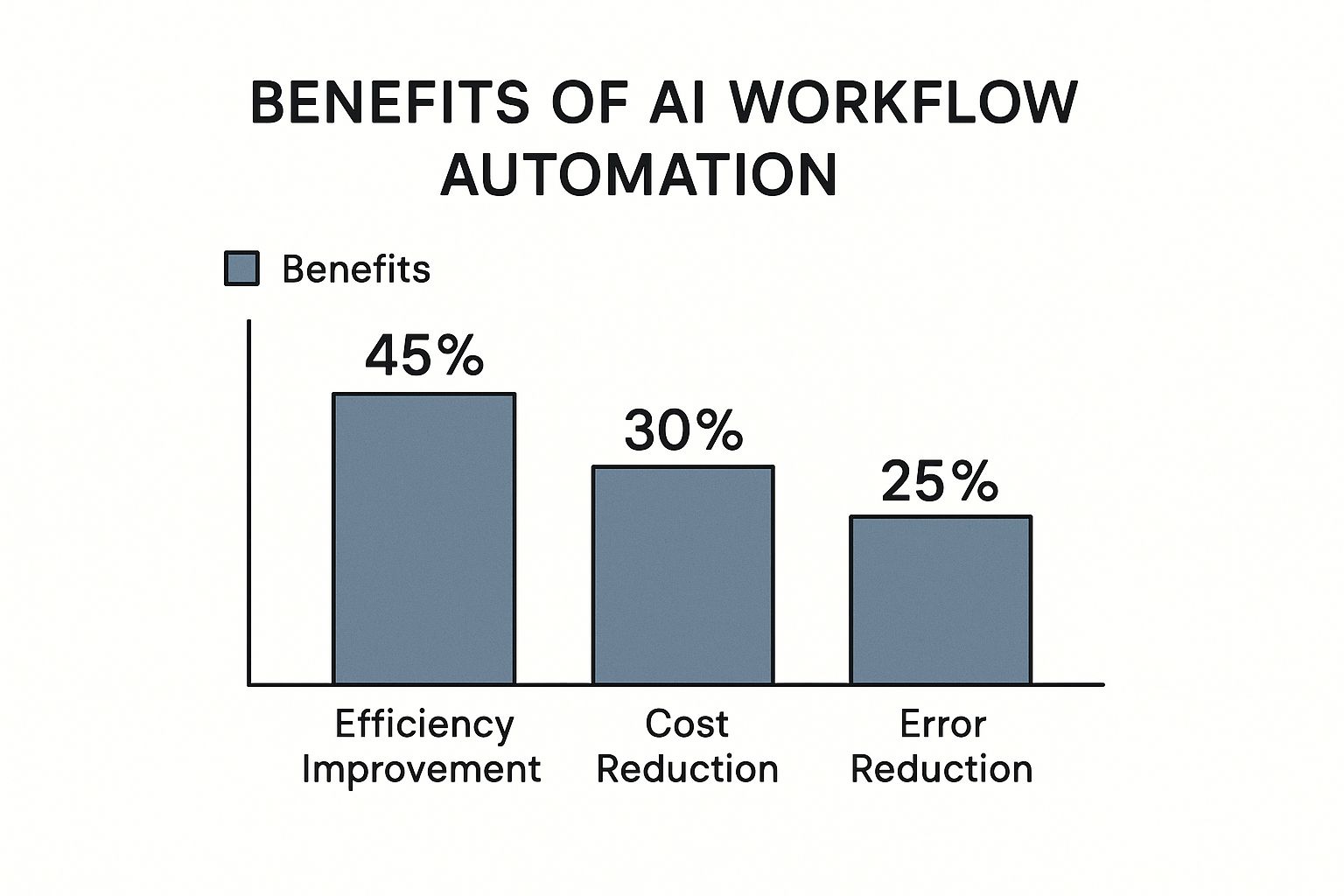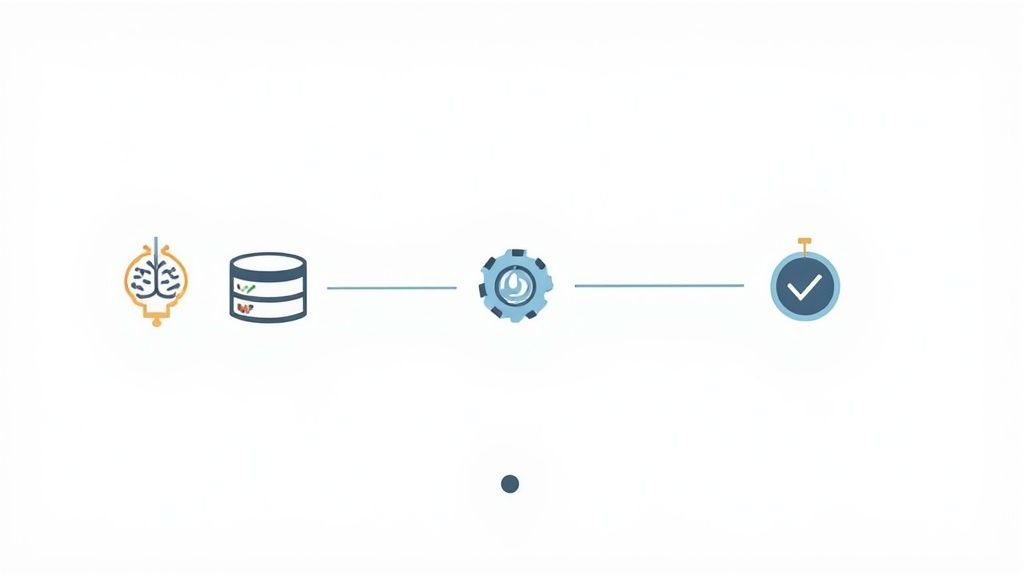The Evolution of AI Workflow Automation
Workflow automation has evolved significantly. What began with simple, rule-based systems now uses the power of Artificial Intelligence (AI) to create dynamic and intelligent workflows. This shift represents a move from basic task sequencing to advanced systems capable of making complex decisions and learning from experience. Instead of simply automating repetitive tasks, AI workflow automation allows businesses to optimize entire processes, boosting efficiency and productivity.
From Basic Automation to Intelligent Workflows
Early automation efforts focused on digitizing manual processes, often with basic scripting or macros. These systems were inflexible and needed significant human intervention to manage exceptions or changes. But the arrival of AI ushered workflow automation into a new age. Machine Learning (ML) algorithms allow these systems to analyze large amounts of data, identify patterns, and adapt to changing conditions without explicit programming. This means AI-powered workflows can learn and improve over time, becoming more efficient and accurate.
For example, consider a customer service workflow. Traditional automation might route inquiries based on keywords. AI can analyze the entire message, understand the customer’s intent, and route it to the best agent, even predicting the optimal course of action. AI can also personalize responses, improving the customer experience. Want to learn more? Check out this guide: How to Implement AI: A Complete Expert Guide
The Expanding Market for AI Workflow Automation
This move to intelligent automation reflects a broader business trend. The growing complexity of operations, combined with the need for greater agility, is driving demand for more sophisticated automation solutions. The workflow automation market is seeing significant global growth. By 2025, the market is predicted to reach USD 23.77 billion and is expected to expand at a CAGR of 9.52%, reaching USD 37.45 billion by 2030. This rapid growth is fueled by the desire to boost productivity, reduce operational costs, and accelerate decision-making. For more statistics, see this report.
Driving Innovation Through Intelligent Automation
Forward-thinking companies are adopting intelligent automation as a key competitive advantage. This combination of AI and workflow technologies provides opportunities to rethink core business functions. By automating complex decisions and optimizing resource allocation, businesses free up employees to focus on strategic initiatives, fostering innovation and growth. This shift lets organizations quickly adapt to market changes, anticipate customer needs, and create new value.
Measuring the Real Value of AI Workflow Automation
Moving beyond the hype, the real question is: what tangible benefits does AI workflow automation actually offer? This section explores the specific metrics organizations use to measure success, from processing time reductions to improvements in accuracy. We'll look at real-world examples of how companies achieve significant cost savings, shorter cycle times, and stronger compliance.
Quantifiable Benefits of AI-Powered Workflows
The advantages of AI workflow automation go far beyond simple cost savings. Successfully implementing these systems often creates a ripple effect of positive changes across different departments.
- Reduced Processing Time: AI can handle tasks much faster than humans, leading to significant reductions in processing times.
- Improved Accuracy Rates: Automation minimizes human error, resulting in more accurate and reliable results.
- Cost Reduction: By automating repetitive manual tasks, companies can cut labor costs and free up resources for other initiatives.
- Enhanced Compliance: Automated workflows can help ensure adherence to regulations and internal policies, reducing compliance risks.
- Improved Customer Experience: Automation can lead to faster response times and more personalized service, which improves customer satisfaction.
- Better Data Quality: AI-powered systems can identify and correct data inconsistencies, resulting in better data for decision-making.
Let's take a look at the core advantages of AI workflow automation in the infographic below.

The infographic shows that efficiency gains (45%) are the most significant benefit, followed by cost reduction (30%) and error reduction (25%). This data highlights the impact of AI workflow automation on key operational areas, paving the way for further innovation and growth. For more inspiration, check out these Top AI Business Examples to Boost Innovation.
Real-World Examples and ROI
Many case studies showcase the substantial return on investment (ROI) businesses achieve with AI workflow automation. One global manufacturer reduced processing time by 78% and improved accuracy. A mid-sized insurance company saw a 3.2x ROI in just nine months. Even government agencies have used AI-driven solutions to improve citizen services and lower operating costs.
Workflow automation also positively impacts employee experience. 89% of employees trust automation for error-free work, and 84% report greater job satisfaction thanks to automation. A McKinsey survey found that two-thirds of respondents saw improved quality control, customer satisfaction, and employee experience, along with significant cost reductions. Robotic Process Automation (RPA) offers substantial savings, costing roughly one-third the price of an offshore full-time employee and one-fifth the price of an onshore worker. For more details, see these automation statistics.
To illustrate the impact of AI workflow automation, let's examine some key performance metrics before and after implementation:
AI Workflow Automation Benefits Comparison
| Business Function | Before Automation | After Automation | Improvement Percentage |
|---|---|---|---|
| Order Processing | 24 hours | 4 hours | 83% |
| Customer Support Response Time | 12 hours | 1 hour | 92% |
| Data Entry Accuracy | 90% | 99% | 10% |
| Compliance Reporting Time | 1 week | 1 day | 86% |
This table showcases significant improvements across various business functions. These results demonstrate the potential for AI workflow automation to revolutionize operations.
Unexpected Benefits and Long-Term Value
Beyond the expected advantages, organizations often find unexpected benefits from AI workflow automation:
Increased Employee Engagement: Freeing employees from tedious tasks allows them to focus on more engaging work, improving morale and job satisfaction.
Improved Innovation: With more time and resources, organizations can invest in research and development, fostering innovation and creating new opportunities.
Greater Agility: Automated workflows enable organizations to react faster to market changes and customer needs, increasing their agility and competitiveness.
These unexpected benefits demonstrate the long-term strategic value of AI workflow automation. By embracing these technologies, organizations can improve operational efficiency and transform their overall performance to drive sustained growth.
Building Your AI Workflow Automation Strategy
Implementing AI workflow automation effectively requires a strategic approach. It's not about simply picking the newest, shiniest tech. It's about truly understanding your existing processes and making sure they align with your overall business goals. This means carefully choosing the right processes to automate, evaluating available technologies, and managing the change within your team. Effective Customer Experience Automation is a key ingredient for business success.

Process Understanding: The Foundation of Success
Before even thinking about technology, successful organizations take the time to understand their current workflows. This involves mapping out every single step, finding any bottlenecks, and identifying areas where automation can make the biggest difference. Focusing on process understanding first helps you pinpoint those high-impact, low-risk processes that are perfect for initial automation projects. This approach minimizes disruptions and maximizes early wins, which creates positive momentum for tackling more complex automation down the road.
Technology Evaluation and Selection
Once you have a solid grasp of your processes, it's time to evaluate and select the right AI tools for the job. Consider things like how well they integrate with your current systems, their scalability, and of course, the cost. For example, if you're working with tons of unstructured data, Natural Language Processing (NLP) capabilities are essential. For those repetitive, rule-based tasks, Robotic Process Automation (RPA) might be a better fit. You can learn more about different AI tools in our article about 10 No-Code AI Tools to Boost Workflow. The key is to pick technologies that meet your specific needs and integrate seamlessly with your existing setup.
Change Management and Governance
Implementing AI workflow automation isn't just about the technical side of things. It also requires managing the change effectively. This means addressing any concerns your employees might have, providing the training they need, and fostering a culture that embraces continuous improvement.
Good governance is also essential. This involves defining clear roles and responsibilities, implementing solid monitoring, and setting up feedback loops to make sure your automated workflows are always optimized. A well-defined governance framework ensures your automation initiatives stay on track with your business goals and continue to deliver real value.
Implementation Timelines and Pitfalls
Realistic implementation timelines are crucial. Don't rush the process. Prioritize thorough planning and testing. Some common pitfalls include poor data quality, inadequate training, and a lack of communication. By anticipating these challenges and addressing them head-on, you can minimize risks and improve your chances of success. Building cross-functional teams and getting buy-in from leadership are essential for ensuring broad support and securing the necessary resources.
Continuous Improvement and Feedback Loops
AI workflow automation isn't a one-and-done project. It’s an ongoing journey of continuous monitoring, evaluation, and adjustment. Integrating feedback loops into your process helps you gather data on how well your automation is performing. This data then allows you to identify areas for improvement and adapt to changing business needs. This iterative approach makes sure your automation initiatives stay effective and deliver long-term value.
The Business Economics of AI Workflow Automation
Investing in AI workflow automation offers much more than just cost savings. This section dives into the true financial impact, exploring the economics beyond basic calculations. By examining successful implementations, we'll discover how to construct comprehensive ROI models that include both tangible and intangible benefits.
Beyond Cost Savings: Unveiling the True Value
AI workflow automation generates value in surprising ways. Improved data quality, for example, leads to better-informed decisions. Additionally, freeing up employee capacity allows organizations to dedicate more resources to innovation and strategic projects. When designing your AI workflow automation strategy, consider platforms like Buildform's DeepOptimize: Buildform’s Always‑On AI for Form Optimization. This shift from routine tasks to strategic thinking significantly impacts a company's bottom line.
Calculating ROI: A Holistic Approach
Creating a robust ROI model involves considering various elements. These include the upfront investment in software and its implementation, ongoing maintenance expenses, and the anticipated savings from improved efficiency and error reduction. However, less tangible benefits are also key. Consider factors such as improved employee morale, better customer satisfaction, and increased business agility. These all contribute to long-term value, even if they are more difficult to quantify.
Timelines for Recouping Investments
The time it takes to recover your investment in AI workflow automation depends on several factors. These include the complexity of the solution you implement, your specific industry, and the particular processes being automated. Some companies see returns within months, others may take a bit longer. A well-defined plan, clear objectives, and a focus on ongoing improvements can significantly shorten the ROI timeline.
Shifting Cost Structures: From Variable to Fixed
AI workflow automation often transforms cost structures from variable to fixed. By automating tasks that once relied on human labor, organizations reduce variable costs linked to salaries, benefits, and overtime. The initial investment in automation becomes a fixed cost, but the long-term savings from lower variable expenses often result in greater financial stability and predictability. This allows for more effective budgeting and resource allocation.
Gaining a Competitive Edge
The projected economic benefits of AI-powered workflow automation are substantial. McKinsey research estimates that AI could inject USD 4.4 trillion in productivity growth potential from corporate applications globally. The AI market is expanding at a CAGR of 37.3% between 2022 and 2030. By 2025, approximately 97 million people are projected to work in the AI field. Explore more statistics here. This rapid growth underscores the transformative potential of AI. Companies using AI workflow automation gain a competitive edge through faster processing, enhanced customer experiences, and greater responsiveness to changing market needs. This agility and efficiency are vital for success in today’s marketplace.

The Future of Business Economics with AI
AI workflow automation is more than just a technological advancement; it represents a significant change in how businesses operate and generate value. By adopting this technology strategically, businesses can optimize processes, empower their workforce, and unlock new levels of efficiency and profitability. This transformation isn't simply about automating individual tasks, but about reshaping the future of work and fostering sustainable growth in the age of AI.
Overcoming AI Workflow Automation Obstacles

Even with the best planning, AI workflow automation projects can hit some bumps in the road. This section explores the common challenges organizations face and offers practical solutions to navigate these hurdles. From integration headaches to employee anxieties, we'll see how successful companies overcome these roadblocks and build thriving automation programs. For more insights, check out this helpful resource: How to master AI adoption in 2025.
Integration With Legacy Systems
Many organizations find it tough to integrate AI-powered automation with their existing older systems. These legacy systems often lack the necessary APIs and data structures for smooth integration. This can lead to the need for custom coding, using middleware solutions like MuleSoft Anypoint Platform, or a phased rollout of automation across different systems over time.
Sometimes, it's a bit like trying to fit a square peg in a round hole!
Data Quality Issues
AI algorithms depend on good, clean data. Inconsistent, incomplete, or inaccurate data can significantly impact AI performance, resulting in inaccurate predictions and automation errors. Think of it like baking a cake – if your ingredients are off, the cake won't turn out right! Addressing data quality through data cleansing, validation, and ongoing data governance is essential for successful AI workflow automation.
Employee Concerns and Change Management
Introducing automation can naturally raise concerns among employees about job security. Successfully managing this change calls for open communication, emphasizing how AI can actually augment human capabilities, not replace them. Reskilling and upskilling programs can empower employees with the skills they need to manage and maintain these automated systems, creating exciting new opportunities within the organization.
Building Technical Capabilities
Implementing AI workflow automation needs specific technical expertise, from data scientists and AI engineers to automation architects and integration specialists. Organizations may need to invest in training, bring in new talent, or collaborate with outside experts to build the necessary technical know-how.
Establishing Governance Frameworks
Solid governance is key for managing AI workflow automation. This involves defining clear roles and responsibilities, putting data security protocols in place, and creating processes for monitoring and auditing automated systems. A well-defined governance framework makes sure AI is used responsibly and ethically, while minimizing potential risks.
Handling Exceptions and Scaling Automation
Automated systems can’t always handle every single situation. It’s important to build in ways to manage exceptions, escalate tricky issues to human operators, and smoothly manage the handoff between automated and manual processes. Plus, organizations need to plan for scalability from the outset, choosing flexible solutions that can adapt to increasing data volumes and changing business needs for long-term success.
Practical Advice for Success
Let's look at a few key strategies that can help organizations overcome these common obstacles:
- Start Small and Scale Gradually: Begin with smaller pilot projects to test and refine your automation strategy before rolling it out across the whole company.
- Prioritize Data Quality: Invest time and resources in data cleansing and standardization to make sure your AI algorithms are working with accurate and reliable data.
- Foster a Culture of Continuous Improvement: Set up feedback loops and regularly monitor your automated workflows to identify opportunities for optimization and refinement.
- Embrace Collaboration and Knowledge Sharing: Encourage open communication and collaboration between technical teams, business stakeholders, and end-users.
The following table summarizes the key challenges and solutions discussed:
| Challenge Category | Specific Issues | Solution Approach | Success Rate (Estimated) |
|---|---|---|---|
| Integration | Difficulty connecting AI tools with legacy systems | Custom coding, Middleware, Phased rollout | Varies widely depending on complexity, typically 60-80% |
| Data Quality | Inconsistent, incomplete, or inaccurate data | Data cleansing, validation, data governance | Can improve accuracy by 70-90% |
| Employee Concerns | Fear of job displacement, resistance to change | Open communication, reskilling/upskilling programs | Positive impact in 70-80% of cases with proactive change management |
| Technical Skills Gap | Lack of in-house expertise | Training, hiring, external partnerships | Dependent on resource allocation and strategy effectiveness |
| Governance | Lack of clear guidelines and oversight | Establish clear roles, data security protocols, monitoring processes | Essential for long-term success and risk mitigation |
| Scalability and Exceptions | Difficulty handling unexpected scenarios, adapting to growth | Building exception handling mechanisms, choosing flexible solutions | Improved performance and adaptability in 60-75% of cases with proper planning |
This table highlights the most common challenges organizations face when implementing AI workflow automation and offers potential solutions, along with estimated success rates based on industry experience. Addressing these challenges proactively is key to achieving a high success rate.
By addressing these challenges head-on and putting effective strategies into action, organizations can unlock the true power of AI workflow automation, boosting efficiency, productivity, and innovation across the entire enterprise.
Real-World AI Workflow Automation Success Stories
Want to see what AI workflow automation can really do? This section explores some inspiring case studies from different industries, showing how real businesses are getting tangible results with AI-powered workflows. From finance to healthcare and manufacturing, these examples demonstrate how AI can truly change the way things work. Looking for inspiration in the creative fields? Check out this resource: Top 10 Ways AI is Changing the Creative Industries.
Manufacturing: Streamlining Production and Boosting Efficiency
One global manufacturer was struggling with complicated production processes. This caused bottlenecks and made things inefficient. By bringing in AI workflow automation, they optimized their production line, automating things like quality control checks and inventory management. The payoff? A whopping 78% reduction in processing time, along with a big boost in accuracy. This streamlined approach didn't just save time and money, it also led to better quality products.
Insurance: Accelerating Claims Processing and Improving Customer Satisfaction
A mid-sized insurance company wanted to make their claims processing better. It was slow and had too many errors. They implemented AI workflow automation to take care of tasks like initial claim assessment and verifying documents. This automation resulted in a 3.2x ROI in just nine months. Plus, faster claims processing made customers much happier, which meant they stuck around longer.
Government: Transforming Citizen Services and Reducing Operational Costs
A government agency set out to modernize its citizen services. They were often complicated and inefficient. Using AI workflow automation, they automated processes such as application processing and distributing benefits. This change greatly reduced operational costs and made citizens considerably more satisfied. Services became faster, easier to access, and much more user-friendly.
Key Takeaways From These Success Stories
These examples offer some valuable insights for organizations thinking about AI workflow automation:
- Start by understanding your challenges: Figure out exactly which problems you want automation to solve.
- Choose the right AI tools: Different industries and processes need different automation solutions.
- Think about efficiency and the customer: AI workflow automation can improve both how your business runs and how happy your customers are.
- Measure your results and keep getting better: Track the important metrics to make sure your automation is delivering real value.
These real-world stories show how powerful AI workflow automation can be for changing business operations across various industries. By learning from these successes, your organization can use AI-driven workflows to achieve its goals and get ahead of the competition.
Ready to transform your own workflows with the power of AI? Join the VibeMakers community! It's a platform for AI enthusiasts, hobbyists, and professionals to connect, learn, and collaborate, giving you valuable resources and support for the world of AI.